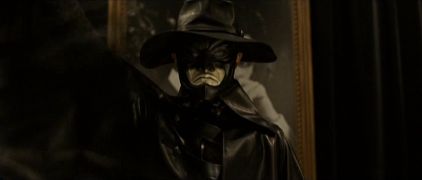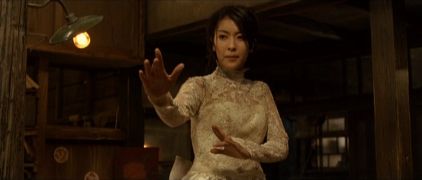« 7 and 7 is | Main | Coffee Break »
January 15, 2010
K-20: Legend of the Mask

K-20: Kaijin niju menso den
Shimako Sato - 2008
Ikano Filem All Region DVD
In a recently published interview, New York Times film critic Manohla Dargis talks about how Hollywood executives don't believe women can direct action films. The very capable Kathryn Bigelow is considered the exception to the rule for now. Shimako Sato doesn't have the painterly eye of Bigelow, but K-20 is entertaining and affecting. Not that I expect Hollywood to call on Ms. Sato, but she did graduate from the London Film School, and her directorial debut was the British Tale of a Vampire, starring Julian Sands.
The origin of the film began with Edogawa Rampo, but reworked by novelist So Kitamura. The film takes place in a retro-futuristic Japan where World War II did not take place. The class structure of the 19th Century is more firmly entrenched with a group of people of immense wealth, and the working poor who live in shanty towns. At the demonstration of a device that can distribute electricity without wires, K-20 appears to create havoc. The literal translation of the title is "the fiend with twenty faces". When not in disguise, K-20 is dressed in black, and is known for his ability to leap in and out of the action, a combination acrobat and magician. A circus performer known for his skills at illusion, Heikichi Endo, is hired by a mysterious man to photograph the high class detective, Kogoro Akechi, with his fiancee, Yoko Hashiba, from a glass ceiling. Endo is mistaken for K-20 and the adventure begins.

While I liked the general retro-future aspects to the film, like the electrical gizmos that are controlled by giant typewriter keys, Sato's decision to change the time period of the story gnaws at me like some insatiable creature. My main problem is that the change from Rampo's 1930s to an alternative 1949 Japan raises, at least for me, many unanswered questions. The brief English language overview of the character Kogoro Akechi does nothing to explain why Sato would want to distance herself as much as possible from Rampo's novels. Ignoring the questions regarding World War II era Japan, the city of Teito seem more modern than the then contemporary Tokyo of, for example, Akira Kurosawa, with hardly a kimono in sight. There are some visual reminders of Tim Burton's Batman, and Sam Raimi's Spiderman, and the music was no doubt inspired by Danny Elman's work for both filmmakers. With the title character as a master of disguise, I more often thought of Raimi's Darkman, with unlikely, reluctant heroes forced by circumstances to mete out justice outside of the law.
Where Sato really has made the difference is in the character of Yoko. An heiress to a vast fortune created by her industrialist grandfather, Yoko turns out not to be a damsel in distress as she first seems. Yoko is by turns clumsy and naive, but also able to whip out a few karate moves, and most importantly fly a tiny helicopter. Depending on the company she keeps, Yoko is either shy or assertive, both the traditional Japanese young woman and the most modern.
In an interview with Mark Schilling, Sato has indicated the hope to make a sequel. What makes K-20 work is that Sato knows enough to aim her film primarily for a pan-Asian audience, with the casting of Takeshi Kaneshiro, and a story with an appropriate balance of fantasy and reality. K-20 may not be of interest to those who would see English speaking actors in films from the big studios. With a 20 million dollar budget that is a fraction of what's spent on a similar Hollywood film, Sato does well with the resources available. The budget may also explain why the film is heavier on exposition than on set pieces. Those parts of the film devoted to action and special effects are worth the wait. There are more than enough examples of women as on screen action heroes. K-20 adds to the argument that a woman can do just as well handling action behind the camera.

K-20: Legend of the Mask is available from HK Flix.
Posted by Peter Nellhaus at January 15, 2010 12:03 AM
